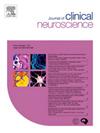Hyperoxia and unfavourable outcome in patients with non-traumatic subarachnoid haemorrhage: A systematic review and meta-analysis
IF 1.9
4区 医学
Q3 CLINICAL NEUROLOGY
引用次数: 0
Abstract
Background
It is common practice to administer oxygen to neurocritical patients in the Intensive Care Unit (ICU). Consequent hyperoxia has been associated with unfavourable outcomes including in patients with brain injury, after cardiac arrest, sepsis, and traumatic brain injury. The aim of this systematic review was to explore the association between hyperoxia exposure and unfavourable outcome in patients following a non-traumatic subarachnoid haemorrhage (SAH).
Methods
Systematic searches of Medline, Embase, Emcare, CINAHL and PubMed were performed in February 2024 using key words for SAH and hyperoxia. Non-human studies, articles in languages other than English, studies that did not measure blood oxygenation levels via pulse oximetry or arterial blood gas analyses, and studies exploring traumatic SAH were excluded. The Newcastle-Ottawa Risk of Bias tool (NOS) was used to assess the quality of included manuscripts. The primary outcome was a composite outcome combining mortality or poor functional neurological outcome. Secondary outcomes included mortality, poor functional neurological outcome, and development of delayed cerebral ischaemia (DCI).
Results
The literature search yielded 1,219 non-duplicate articles published after 1 January 2000, of which 21 articles were reviewed as full-texts and nine were included in this review. All included studies were rated good/high quality using the NOS. Hyperoxia exposure was associated with increased risk of adverse composite outcome of death or unfavourable functional neurological outcome (odds ratio (OR) 1.61, 95% confidence interval (CI) 1.19–2.16), poor functional neurological outcome alone (OR 1.79, 95% CI 1.33–2.42) and development of DCI (OR 2.63, 95% CI 1.79–3.85). The association of hyperoxia and hospital mortality alone was not statistically significant (OR 1.42, 95% CI 0.98–2.04).
Conclusion
Hyperoxia may contribute to unfavourable outcomes and the development of DCI after an non-traumatic SAH. Trials using restrictive oxygen therapy among patients with SAH are indicated.
非外伤性蛛网膜下腔出血患者的高氧和不良结局:系统回顾和荟萃分析
背景:在重症监护病房(ICU)给神经危重症患者输氧是一种常见的做法。随之而来的高氧与包括脑损伤、心脏骤停、败血症和创伤性脑损伤患者在内的不良结局有关。本系统综述的目的是探讨高氧暴露与非外伤性蛛网膜下腔出血(SAH)患者不良预后之间的关系。方法以SAH和高氧为关键词,于2024年2月对Medline、Embase、Emcare、CINAHL和PubMed进行系统检索。非人类研究、非英语语言的文章、未通过脉搏血氧仪或动脉血气分析测量血氧水平的研究以及探索创伤性SAH的研究均被排除在外。使用纽卡斯尔-渥太华偏倚风险工具(NOS)评估纳入稿件的质量。主要转归是综合转归,包括死亡率或神经功能不良转归。次要结局包括死亡率、功能不良的神经预后和迟发性脑缺血(DCI)的发展。结果检索到2000年1月1日以后发表的非重复文献1219篇,其中21篇被纳入全文,9篇被纳入本综述。所有纳入的研究均被NOS评为良好/高质量。高氧暴露与死亡不良综合结局或不良神经功能结局(比值比(or) 1.61, 95%可信区间(CI) 1.19-2.16)、单独不良神经功能结局(or 1.79, 95% CI 1.33-2.42)和DCI发展(or 2.63, 95% CI 1.79 - 3.85)的风险增加相关。单纯高氧与住院死亡率的关联无统计学意义(OR 1.42, 95% CI 0.98-2.04)。结论高氧可能导致非创伤性SAH后不良预后和DCI的发展。在SAH患者中使用限制性氧治疗的试验是有指示的。
本文章由计算机程序翻译,如有差异,请以英文原文为准。
求助全文
约1分钟内获得全文
求助全文
来源期刊

Journal of Clinical Neuroscience
医学-临床神经学
CiteScore
4.50
自引率
0.00%
发文量
402
审稿时长
40 days
期刊介绍:
This International journal, Journal of Clinical Neuroscience, publishes articles on clinical neurosurgery and neurology and the related neurosciences such as neuro-pathology, neuro-radiology, neuro-ophthalmology and neuro-physiology.
The journal has a broad International perspective, and emphasises the advances occurring in Asia, the Pacific Rim region, Europe and North America. The Journal acts as a focus for publication of major clinical and laboratory research, as well as publishing solicited manuscripts on specific subjects from experts, case reports and other information of interest to clinicians working in the clinical neurosciences.
 求助内容:
求助内容: 应助结果提醒方式:
应助结果提醒方式:


